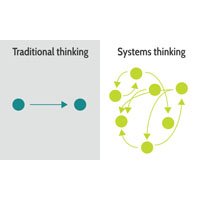Anything that has multiple parts which work collectively to reach common goals has to be driven by a system. Such multiple parts cannot work independently and still reach common goals.
This simple and fundamental fact is not taken into consideration by scientists, who study various aspects of human brain in greatest of details, but do not see it as one integrated system.
Many functional components of the brain are interdependent and do not work in a linear fashion. To study how the brain works, a holistic approach of a goal driven system is required, which studies how its components interrelate and interact with each other, while interacting with other external systems and their components. Such an approach is aptly called the ‘Systems Thinking’ approach.
With the systems thinking approach, one studies relationships, connectedness and contexts of the elements of a system. Shifting focus from parts to the whole results in better understanding of the system and its emergent phenomena by understanding functional roles of its elements.
For the last 10 years, I have been working full-time decoding the operating system (OS) of the brain by studying how it works as a single system using systems thinking approach.
As a result, I have developed Dichotomized Operating System Model (DOS Model), which is a functional model that reveals a single system consisting of more than 50 hierarchically interconnected goal-driven mechanisms and processes running in the brain that work together and form what we collectively call “mind”, including the mechanism of “self”.
It is the only existing causal account of the human brain and is based on the mechanism of Natural Selection proposed by Charles Darwin in the year 1859 in his book “On the Origins of Species – By Means of Natural Selection”.
More about Systems Thinking
Systems thinking involves shifting attention…
- from the parts to the whole
- from objects to relationships
- from structures to processes
- from hierarchies to networks
- from the rational to the intuitive
- from analysis to synthesis
- from linear to non-linear thinking
The ideas set forth by organismic biologists during the first half of the twentieth century helped to give birth to a new way of thinking — “systems thinking” — in terms of connectedness, relationships, context. According to the systems view, the essential properties of an organism, or living system, are properties of the whole, which none of the parts have. They arise from the interactions and relationships among the parts. These properties are destroyed when the system is dissected, either physically or theoretically, into isolated elements. Although we can discern individual parts in any system, these parts are not isolated, and the nature of the whole is always different from the mere sum of its parts.
- Fritjof Capra (1996) The Web of Life p. 29.
Video on Systems Thinking
Systems Thinking – https://youtu.be/Miy9uQcwo3U
Synthesis & Analysis – https://youtu.be/GARpWOLqP6E
Systems & Sets – https://youtu.be/U7RzKZQjAK8
Links for 2 systems approach (dual process theory):

